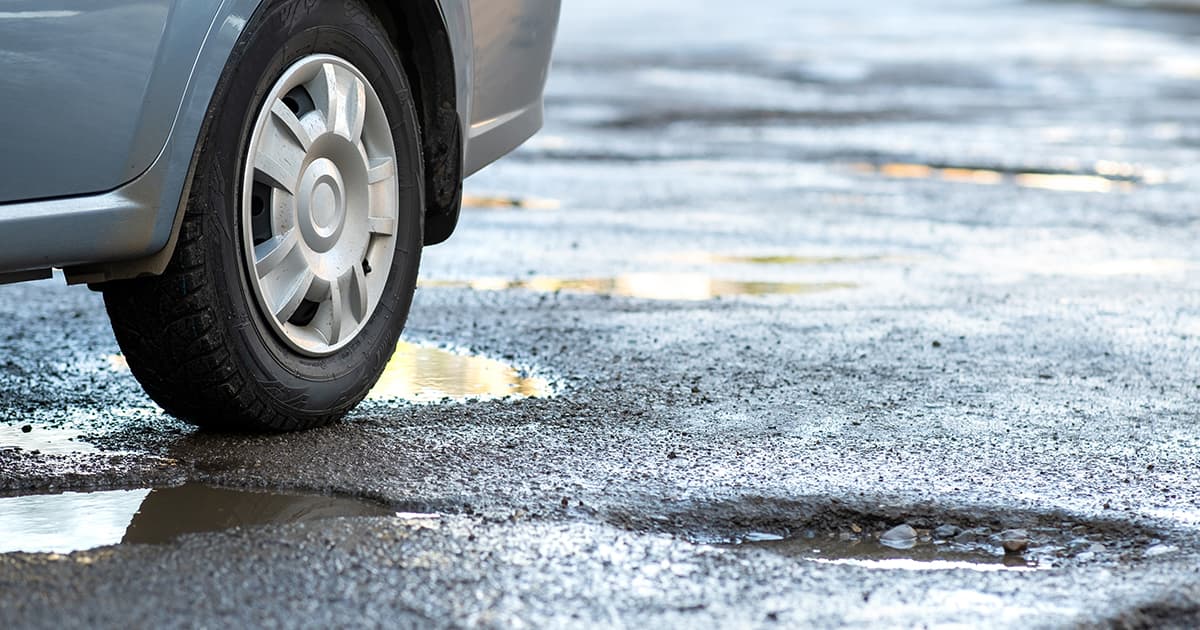Happy Spring! How to Navigate Potholes

Spring is finally here and so are potholes, the mark of one Canadian season – winter – changing to the other - construction.
Winter creates potholes, which is why there are so many in the spring. Fluctuations in temperature cause frozen asphalt to expand and contract, weakening the soil under it. After a few cars drive over it, a pothole is born.
How do potholes damage your car?
Potholes might seem like a minor annoyance, but they can damage your vehicle and cause problems such as:
- A blown-out tire
- Alignment issues
- Bulges on tire sidewalls
- Dents on wheel rims
- Loss of control of your car
- Problems with steering
- Suspension issues
If you experience losing control of your car, bottoming out, or swaying when making turns, have your car looked at by mechanic.
How to avoid potholes
Though it is not always possible, protect your car by taking the time to look for potholes and then avoiding them as much as you can.
Slow down
If hitting a pothole is unavoidable, take your foot off the gas to slow down before driving over it but do not brake. Braking can cause loss of control of your vehicle and more damage than driving over the pothole.
Approach cautiously
Potholes can be larger than they look if they are filled with water, so be careful when driving around them.
Keep a firm grip on the steering wheel
If you have to drive over a pothole, hold the steering wheel firmly and drive straight. Avoid turning into potholes because this could damage the tire sidewall. The sidewall supports the vehicle and affects how comfortable riding in your car is.
Check your tire pressure
Keeping your tires inflated to the pressure recommended by the owner’s manual helps them stand up better to potholes.
Which Canadian cities have the most potholes?
While there is no apples-to-apples comparison of the number of potholes in Canadian cities, there are a few notable problem areas and differences between provinces. A 2021 report for the Canadian Automobile Association found that, on average, Canadian drivers pay $126 more per vehicle every year because of driving on poor-quality roads.
The cost of poor roads to drivers is the highest in Quebec at $250, followed by Atlantic Canada. More than half of the highway kilometers in Nova Scotia and Quebec show signs of deterioration or are deteriorated.
Quebec
Around 50,000 potholes are repaired annually in Montreal and, in another survey, Quebec drivers were more likely to say their roads are “poor” or “very poor” than drivers in other provinces. 24.5% of local roads received this rating as did 35.6% of highways.
Atlantic Canada
Atlantic Canadians claim that the top three worst roads are:
- New Brunswick 616 in Keswick Ridge, N.B.
- Pine Glen Road in Pine Glen, N.B.
- Brae Harbour Road in Coleman, P.E.
In Nova Scotia, 49% of highways are rated “poor” or “very poor,” as are 30.7% of local roads.
Saskatchewan
In Saskatchewan, 30.7 % of publicly owned highways were rated poor or very poor, but only 7.5% of local roads were.
Edmonton
By Feb 5, 2023, 5310 potholes were repaired in Edmonton, triple the 2022 number. The city’s budget for pothole repair is over $10 million.
Calgary
In Calgary, about 16,000 potholes are repaired every year, mostly from April to September.
Ottawa
In Ottawa, more than 1.1 million potholes have been filled since 2018 and the pothole budget for 2023 is close to $11 million.
Lower Mainland
Potholes are not a problem that is specific to areas with harsh winters. Even the Lower Mainland is getting more potholes than usual this year because of snow and sub-zero temperatures followed by rain, which caused cracks and allowed moisture under the asphalt’s surface.


.jpg?300x300)
